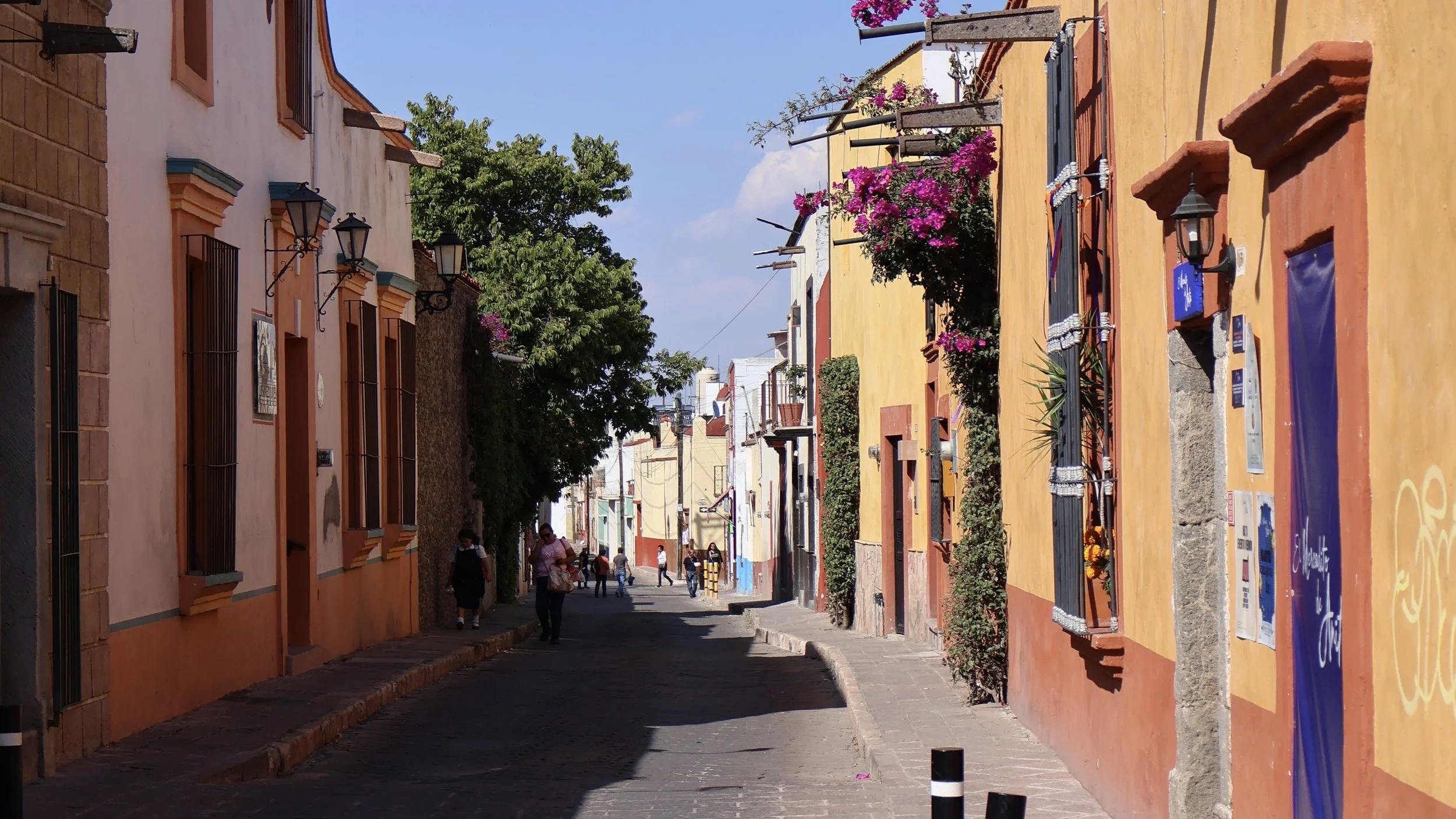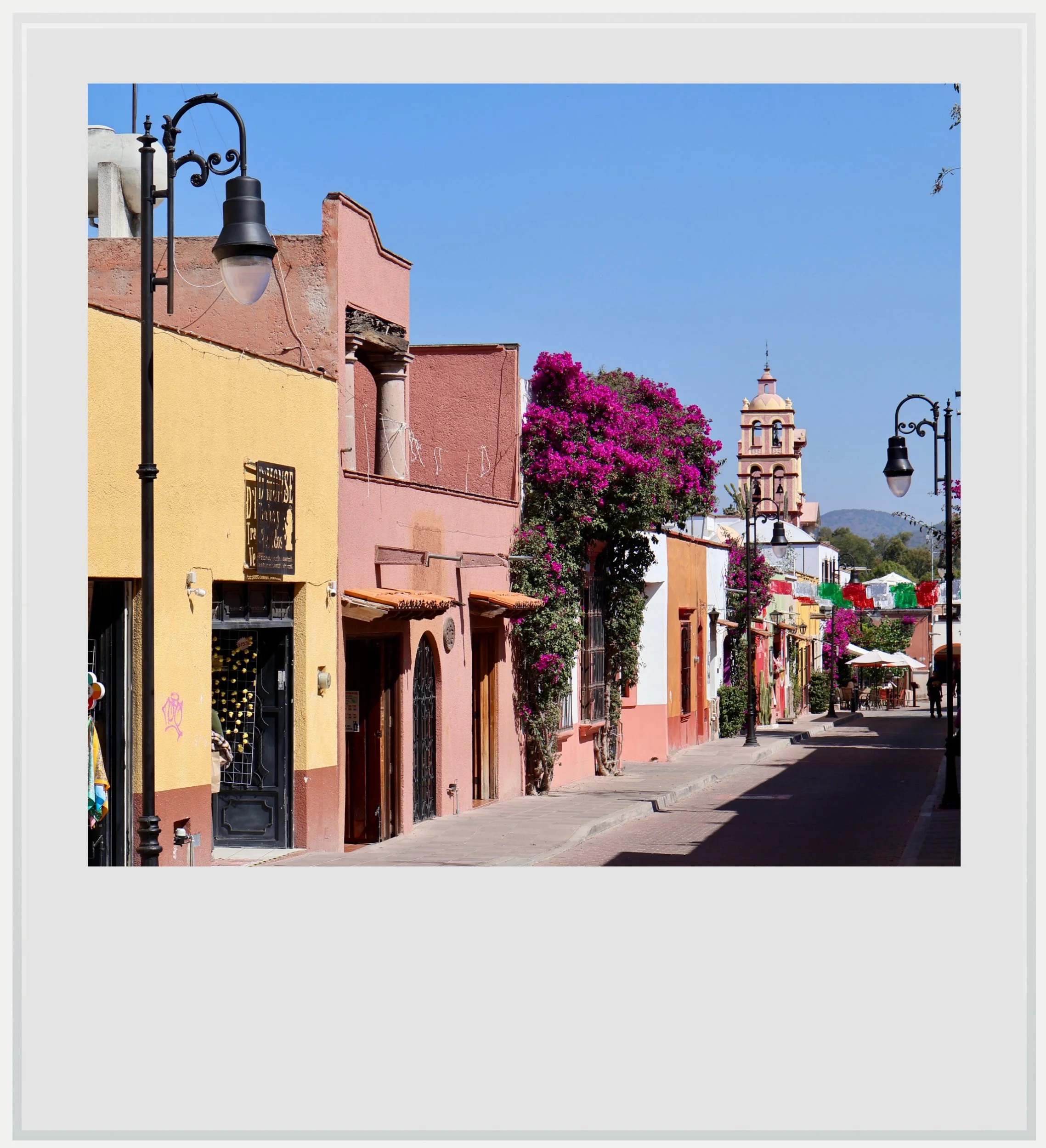A Day in Tequisquiapan, Mexico
A colonial gem filled with bright colors and bougainvillea trees.
The bright morning sun was starting to burn my skin, as I was waiting for a public bus that would get me to Tequisquiapan, on the sidewalk of Bernal’s main thoroughfare, calle Benito Juarez. The morning hadn’t started very well. I had been waiting at the main bus stop where buses call on their way to Santiago de Querétaro, only to see two of the yellow, decrepit buses I was supposed to take get into the street a few years ahead of me.
The people waiting with me for a bus to Querétaro had been adamant I was in the right place. Viene ahorita, no se preocupe (“the bus will come soon, don’t worry”). After seeing the second bus pass me by, as if trying to avoid me, I decided to walk further up the street until the next bus stop.
Then I waited. And waited. It turned out if two buses pass in quick succession, you can expect the third one to come much later, and this is what happened.
After almost 45 minutes spent waiting, another yellow bus finally showed up. Getting on the bus felt like an achievement. Little did I know it was just the beginning. Getting from Bernal to Tequisquiapan by public transport is a work of patience and dedication (as always, I detail the “how” in the Practical Information section at the end of this piece).
The drive between the two towns usually takes 40 minutes, and I could have certainly taken a cab (there are no Ubers in Bernal), but I felt adventurous and decided to chance it. I was also motivated by the fact I couldn’t find any info online on how to do that, so it felt like a challenge I could win, and share with everyone.
It turned out this yellow bus was part of an official bus system called Microbus Amarillo, that links Bernal to the bigger town of Ezequiel Montes (if you have read my Bernal article, you know that the town of Bernal was actually incorporated into the town of Ezequiel Montes back in 1940). It also turned out this was the slowest service I have ever been on – and it's not a small feat. I took many bus rides in El Salvador, after all.
While Bernal feels like a sleepy village, Tequisquiapan is all hustle and bustle.
Beyond the center of Bernal lie a few newer developments and that bus was interested in checking out almost every single road within them. It benefits people coming from town with heavy packages, but it makes the trip unbearably long if your objective is to get to Tequisquiapan. I’ll add here I was in the minority in riding this bus for most of its route, so this isn’t a criticism, but more of a heads up if you decide to do the same.
Once it passed the last of these suburban colonias, the bus accelerated on carrera Bernal, and then on carrera 120. The wind blowing through the open windows felt like a nice natural AC unit, and we only stopped a couple of times in the last miles to pick up high-school students in uniform.
Once in Ezequiel Montes, booths for buses to Tequis are a few steps away, and there is a good chance one of the two companies offering the service will have a bus leaving in the next 15-20 minutes during the day. If it’s Flecha Roja, you’re in luck as its buses are modern first-class buses, with wide reclining seats and A/C. They will make you forget the first part of the trip.
It was early afternoon when the bus dropped me on Tequis’ busy, noisy main street and I quickly made a beeline to a side street leading to the historical center. It would be hard to make a fair comparison between Bernal and Tequis. Three thousand people live in the former while the latter has a population of around fifty-five thousands, so it is several scales of magnitude bigger.
While Bernal feels like a sleepy village (especially during the week), Tequisquiapan is all hustle and bustle. Yet a few minutes into walking towards the center, the noise receded and I felt like I was walking in another quiet little town of the Mexican highlands.
The town’s historical center is fairly well preserved, and smart urban planning leaves some of it car-free, so pedestrians can enjoy a big part of it without cars around. Tequis epicenter is most certainly plaza Miguel Hidalgo. The square is huge, and could be considered the town’s zócalo, lined with shops and restaurants as well as the Santa Maria de la Asunción church. Photo enthusiasts will also find not one but two “Tequis” signs to take photos of.
While I liked the town’s main square, I really loved the cobblestone streets surrounding it. First, the square is huge – it actually looked too big for the town, and, to me, felt like these huge, empty squares in soviet Russia where one feels too small to really appreciate anything. Other zócalos can feel like this, Mexico City’s is one of them for me, but I have been to many other zócalos where I felt like I could sit down and spend a few minutes without feeling oppressed or overwhelmed (Puebla’s is a good example of that). For Tequis, I think the combination if its sheer size and the low scale of the buildings surrounding it made it an odd architectural sight.
The streets leading to plaza Miguel Hidalgo, however, were wonderful. Lined with traditional shops, featuring grand historic villas, a lot of them covered in beautiful blooming bougainvilleas, they made me a fan of Tequisquiapan.
The actual geographical center of Mexico is in Tequis… or is it?
My favorite street, and probably the most photogenic of all, was calle Niños Heroes. Starting from the south of plaza Miguel Hidalgo, it climbs slightly as it curves along beautiful houses and leads to a little square with a sculpture celebrating the geographical center of Mexico. In 1916, then President Venustiano Carranza decided to award the town, which he liked very much as a weekend getaway from Mexico City, this distinction, and in 1978, the town installed the pendulum that marks the theoretical center of the country where it is today.
There is only one issue with this. The actual geographical center of Mexico is very close to Villa de Cos, in the state of Zacatecas, a seven-hour drive north of Tequis. For a moment, as I looked at the pendulum, I forgot all sense of geographical accuracy, and enjoyed the feeling of being very much at the center of everything.
Another place I quite like in Tequis was San Joaquin park, a small but beautiful and quiet little green space a few blocks from the main square. It will be part of your natural itinerary as you discover all the charming streets in the center, and it’s a great place to take a breather and relax.
Fearing the same sort of ordeal to head back to Bernal, I left Tequis before sunset, to be able to find my way back easily. I am happy to report that the trip back (in a bus) was smoother than on the way out – probably because I knew what I was doing. I was back in Bernal just as night was falling, happy I spent a few hours away in Tequis.
Practical information
Getting to Tequisquiapan
- From the US: Querétaro City counts with an airport (IATA code QRO) that has non-stop service, at time of writing, to Houston, Detroit, Chicago, Dallas and San Antonio. Once at the airport, a quick Uber ride will get you to the bus station, where you can take a 90mn bus ride to Tequisquiapan. Flecha Azul is the main company serving the route. Tequis’ bus station is within walking distance of the historical center.
- From CDMX: a few bus companies offer direct service from Mexico City’s Northern Bus station (Terminal de Autobuses del Norte) which is easily reached by Uber or bus from anywhere in the city. My readers know I love ETN, the luxury one, but you may choose a first class bus instead. ETN serves the route up to three times a day and drops you at Tequis’ bus station, about 10-15 minutes by foot from the historic center.
- From Bernal (this is especially useful if you’re trying to hit both Bernal and Tequisquiapan in one trip). The easiest way is way taxi (there is no Uber service in the area) and should cost around 450 pesos, for a 40-minute journey. You can, like me, rough it up for a lot less and use bus service, for about a tenth of the price of a cab. For 22 pesos, take a yellow bus at any of the yellow bus stops in Bernal (I recommend this one from personal experience). They will go through a bunch of suburban colonias on their way to Ezequiel Montes, the next big town over (that’s the very slow part) and eventually reach route 120 and zip to a street corner off the town’s center. From there, walk a few feet to the Flecha Roja and Servicios Coordinados shops, located right next to each other, and inquire about the next bus going to Tequis. Take the first one, knowing that Flecha Roja is a first class service (A/C, designated seats, great recline). Both companies will drop you at the Tequisquiapan bus station, on the outskirts of the historic center (which you can reach in an easy 10-15 minute walk). That second leg should cost you about the same (around 20 pesos). The whole trip is around 75 minutes, including the stop in Ezequiel Montes, but costs around 45 pesos, so it is much more economical than taking a cab.
Safety
- The US State Department labels Querétaro as a level 2 state, meaning “Exercise increased caution” when you travel. Like most places in Mexico, it is very safe (this level 2 also applies to countries like Spain or Italy, which are not known for their crime levels). Behave as you would in a place you don’t know, especially if you don’t speak the language, and you will be fine. I never felt unsafe at any point in Tequisquiapan during my (limited) time there.
Restaurants and souvenirs
- Casa Suelem – I only had one chance to experience Tequis cuisine, so I picked a safe choice. Casa Suelem is a nice restaurant a block away from the main square. I picked the tacos menu: you get 5 fancy tacos and each of them comes with its own wine pairing. The meal was delicious and worth it.
Photos from top to bottom: a street in Tequis’ historical center, plaza Miguel Hidalgo with the Santa Maria de la Asunción church, calle Ninos Heroes, avenida Juarez looking towards plaza Miguel Hidalgo, calle Veinte de Noviembre.
All photos are mine.




